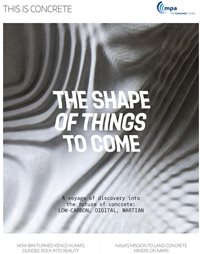Concrete Futures
Dedicated to exploring innovation, research and new developments
 Concrete Futures is a lecture and magazine series which is dedicated to exploring the innovation, research and new developments in concrete. Recent and evolving concrete innovations, including the use of alternative constituent materials and digital technology, is fundamental to improving the efficiency of manufacturing, design and construction processes. These innovations have the potential to change the properties and performance of concrete and create opportunities to develop how we use concrete in the future.
Concrete Futures is a lecture and magazine series which is dedicated to exploring the innovation, research and new developments in concrete. Recent and evolving concrete innovations, including the use of alternative constituent materials and digital technology, is fundamental to improving the efficiency of manufacturing, design and construction processes. These innovations have the potential to change the properties and performance of concrete and create opportunities to develop how we use concrete in the future.
__________________________________________________________________________________________________
Watch one of our webinars
This event features two new concrete technologies. The first involves the use of alternative materials in the making of concrete – a carbon negative secondary cementation material, that can capture CO2 process emissions of cement in its manufacture and also reduce the embodied carbon of concrete when used. And the second technology presented is 3D printed concrete, for automated creation of structures, with this product also enhanced using graphene. View now.
The use of lower carbon concretes and cements is a key lever in the UK concrete and cement industry roadmap to beyond net zero. This event recording provides an update on research to expand the range of lower carbon concretes covered by BS 8500, innovation in precast concrete and practical guidance for the use of other lower carbon concretes using alkali-activated cements (AACMs).
Speakers include cement experts and concrete technologists, who will update on multi-component cements in BS 8500 and representatives from contractors who will look at innovative solutions for carbon reduction using precast concrete and practical guidance to the use of Geopolymer and Alkali Activated Cement concretes in projects happening now. View now.
Decarbonising the UK's electricity supply is fundamental to achieving net zero carbon commitments and increasing the availability of renewable energy forms a vital part of that commitment.
This Concrete Futures lecture showcases innovations that have the potential to support the effective supply of zero carbon energy including wind, wave, gravity, and kinetic solutions. It also explores the use of concrete structure as a smart thermal store to help address the challenges of intermittent energy supply and improve its efficiency. View now.
A supporting Concrete Futures article on the topic of renewable energy is also freely available. Download here.
This event showcases some of the new generation of low carbon concretes and explores their current, and potential uses, and their carbon footprint.
It is hosted by Elaine Toogood, from The Concrete Centre, and includes presentations by MPA Cement; Cemex; OCO Technology, Solidia and Aggregate Industries. View now.
This event features presentations from three leaders in the field of bioreceptive concrete, each presenting their specific developments, its potential uses and benefits.
They include Poikilohydric Living Walls, by Professor Marcos Cruz, Biocrete paving by Dr Elizabeth Gilligan and EcoStructure (concrete flood defences to support marine biodiversity) by Dr Ciaran NcNally.
The event commences with an overview of concrete and biodiversity by Elaine Toogood, The Concrete Centre. View now.
Further reading

Concrete provides non-combustible structures for our homes, schools, hospitals and offices, and the thermal mass to cool them in warmer summers without energy-intensive cooling systems. This publication looks at the 'shape of things to come' with concrete as innovators are reformulating cement to be less energy-intensive or replacing it completely, devising alternatives to fine aggregate such as waste plastic and inventing new types of reinforcement that can bend, be 3D-printed in fibre form or even transmit light.